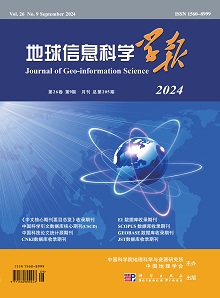Information Extraction of Typical Alteration Mineral Assemblage in Porphyry Copper Using ASTER Satellite Data, Arequipa Province of South Peru
引用次数: 4
Abstract
In this paper we studied the information extraction technology of alteration mineral assemblages.Using the standard laboratory spectral database of U.S.Geological Survey,we rebuilt the reflectivity curve of key alteration minerals in porphyry copper alteration zones with ASTER data.After comparative analysis of these key alteration minerals spectral curves,we found the characteristic of absorption valley at the spectral 2.2 μm(which is corresponding to the B6 of ASTER data) of the argillic-and phyllic-altered mineral assemblage(which include muscovite,kaolinite,montmorillonite,alunite,illite,etc.),and with the characteristic of high reflection peaks at B4 and B7.The characteristic of absorption valley at the spectral 2.3 μm(which is corresponding to the B8 of ASTER data) of the propylitization altered mineral assemblage(which include chlorite,epidote,calcite,etc.,),and with the characteristic of a high reflection peaks at B4,while the B9 has a higher reflectivity than the B8.Accordingly,the principal component analysis model was developed.This model can make component analysis based on ASTER B1,B4,B6 and B7 to extract the argillic-and phyllic-altered mineral assemblage;component analysis based on ASTER B1,B3,B4 and B8 to extract propylitization altered mineral assemblage.At the same time,the process was established for the alteration mineral assemblage information extraction.Taking porphyry copper region in Arequipa Province of south Peru as an example,based on comprehensive analysis of the geological background of the study area,especially its typical alteration zoning and alteration mineral assemblages in the area,we found a typical porphyry alteration zonation in Arequipa Province.So we can take advantage of the technical processes and methods,and after ASTER data preprocessing,interfering surface features removal,principal component analysis and threshold setting,to extract argillic-and phyllic-altered mineral assemblage and propylitization altered mineral assemblage.Meanwhile,together with remote sensing interpretation and regional geochemical data,we forecasted the prospecting target of porphyry copper,and delineated 4 remote sensing exploration targets.Comparing with the verified of high-resolution satellite images and the known porphyry copper deposit,the result this study is reliable.利用ASTER卫星数据提取秘鲁南部阿雷基帕省斑岩铜矿典型蚀变矿物组合信息
本文对蚀变矿物组合信息提取技术进行了研究。利用美国地质调查局标准实验室光谱数据库,利用ASTER数据重建斑岩铜蚀变带关键蚀变矿物的反射率曲线。通过对这些关键蚀变矿物光谱曲线的对比分析,发现泥质和叶状蚀变矿物组合(包括白云母、高岭石、蒙脱石、明矾石、伊利石等)在光谱2.2 μm处(对应ASTER数据的B6)具有吸收谷特征,并在B4和B7处具有高反射峰特征。丙基化蚀变矿物组合(包括绿泥石、绿帘石、方解石等)在光谱2.3 μm处(对应ASTER数据的B8)具有吸收谷特征,且在B4处具有高反射峰特征,其中B9的反射率高于B8。据此,建立了主成分分析模型。该模型可基于ASTER B1、B4、B6、B7进行组分分析,提取泥质蚀变矿物组合;基于ASTER B1、B3、B4、B8进行组分分析,提取丙基化蚀变矿物组合。同时,建立了蚀变矿物组合信息提取流程。以秘鲁南部阿雷基帕省斑岩铜矿区为例,综合分析研究区地质背景,特别是该区典型蚀变分带和蚀变矿物组合,发现了阿雷基帕省典型的斑岩蚀变分带。因此,我们可以利用ASTER数据预处理、去除干扰表面特征、主成分分析和阈值设置等技术流程和方法,提取泥质蚀变矿物组合和丙基化蚀变矿物组合。同时,结合遥感解译和区域地球化学资料,预测了斑岩铜矿找矿靶区,圈定了4个遥感找矿靶区。通过与高分辨率卫星图像验证和已知斑岩型铜矿床对比,研究结果是可靠的。
本文章由计算机程序翻译,如有差异,请以英文原文为准。
求助全文
约1分钟内获得全文
求助全文
来源期刊
CiteScore
2.70
自引率
0.00%
发文量
3757
期刊介绍:
Journal of Geo-Information Science is an academic journal under the supervision of Chinese Academy of Sciences, jointly sponsored by Institute of Geographic Sciences and Resources, Chinese Academy of Sciences and Chinese Geographical Society, and also co-sponsored by State Key Laboratory of Resource and Environmental Information System, Key Laboratory of Virtual Geographic Environment of Ministry of Education and Key Laboratory of 3D Information Acquisition and Application of Ministry of Education. Founded in 1996, it is openly circulated in the form of a monthly magazine.
Journal of Geoinformation Science focuses on publishing academic papers with geographic system information flow as the main research object, covering research topics such as geographic information cognitive theory, geospatial big data mining, geospatial intelligent analysis, etc., and pays special attention to the innovative results of theoretical methods in geoinformation science. The journal is aimed at scientific researchers, engineers and decision makers in the fields of cartography and GIS, remote sensing science, surveying and mapping science and technology. It is a core journal of China Science Citation Database (CSCD), a core journal of Chinese science and technology, a national Chinese core journal in domestic and international databases, and it is included in international databases, such as EI Compendex, Geobase, and Scopus.

 求助内容:
求助内容: 应助结果提醒方式:
应助结果提醒方式:


